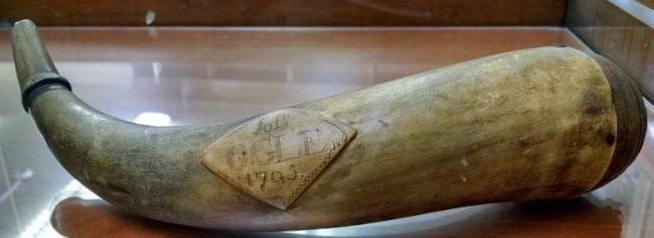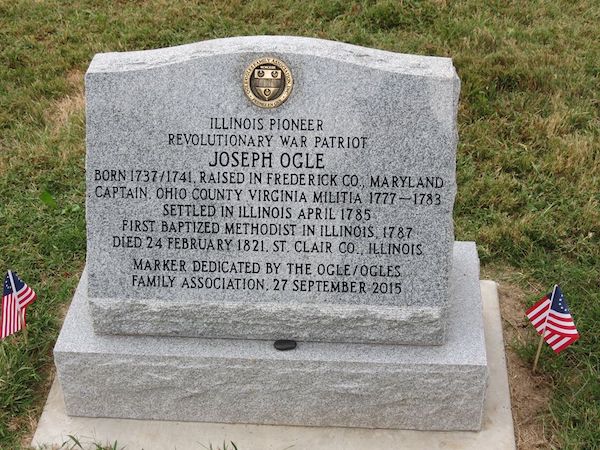Ogle’s legacy lives on

The Columbia City Council approved a preliminary plat for the Ogle Estates subdivision on Aug. 2.
While the development is a modest, 10-lot plan near Eckert Lane in the northern part of the city, its namesake honors a man who came to the area before Monroe County existed or Illinois was even a state.
While different sources, including his grave marker, are uncertain whether Joseph Ogle was born in 1737 or 1741, or whether it was in Virginia, Maryland or Delaware, his impact on Southern Illinois is undisputed.
Ogle was one of the founders of the New Design settlement south of Waterloo, as well as leader of the first Methodist class in Illinois. He also owned a sizable tract of land in the northern part of Columbia before eventually settling in what is now the O’Fallon area of St. Clair County.
Ogle County in Illinois was formed in 1836 out of Jo Daviess and LaSalle counties and named after the Revolutionary War veteran.
In 1777, Ogle led the Ohio County, Va., militia against a band of British and Native American forces in the Siege of Fort Henry. He commanded under the rank of captain, given to Ogle by Patrick Henry, the state’s governor at the time.
After the war, Ogle returned to the area of Wheeling, Va. (now W.V.), where he had served during the war.
In 1785, citing an opposition to slavery in Virginia, Ogle made his way to Piggot’s Fort in what is now Columbia, but was then just the southwest corner of the frontier known as the Northwest Territory.
Another Revolutionary War soldier who also found himself in Wheeling after the war was James Lemen Sr. Lemen married Catherine Ogle, Joseph’s daughter, and followed to Illinois in 1786.
Shortly after Lemen arrived, he and Ogle began the first settlements at New Design south of Bellefontaine (now Waterloo), and the area became a popular destination for immigrants arriving from Kentucky or Virginia.
“Skirmishes” with Native Americans marked Ogle’s time as a New Design settler.
Tragedy befell the Ogle family in 1786 when his daughter and son-in-law Elizabeth and James Andrews, along with 3-year-old granddaughter Drusilla, were taken captive by Native Americans from their home about two miles north of Bellefontaine.
James, who had been shot by a raiding party before his home was ransacked, was found dead several days later. Elizabeth was found murdered about a quarter mile from the house.
After search parties were unable to locate Drusilla, Ogle offered a “liberal reward” to the French traders in St. Louis for safe return of his granddaughter.
After a short captivity, being taken as far north as Prairie du Chein, Wisc., Drusilla was returned to New Design and went to live with the Lemen family.
As an adult, Drusilla married Henry Mace and returned to live and raise a family near the site where she was taken as a child.
Two years later, in December 1788, Ogle’s son Benjamin survived being shot in the shoulder while “hauling hay from the Bottoms” with three other men. Two of the men were killed and scalped while another managed to escape without injury.
In 1791, Joseph and Benjamin Ogle, along with Lemen and others, were involved in a pursuit of a group of Native Americans after John Dempsey, who had survived being scalped and left for dead in 1789, and once again escaped death after being attacked.
According to the Combined History of Randolph, Monroe and Perry Counties, a band of men pursued the group that attacked Dempsey to a place known as “Big Spring, about five miles north of the present town of Waterloo, and a short distance east of the St. Louis road.”
The fight was described as “tree to tree” with no casualties or injury to those in Ogle’s party, who reportedly killed five members of the group they pursued.
Shortly after the battle, Benjamin became a Baptist minister, a profession he held the rest of his life. His father Joseph soon found religion as well.
In 1793, a “circuit rider” – a Methodist itinerant preacher to new American settlements – from Kentucky named Rev. Joseph Lillard established the first Methodist class in Illinois at New Design. Lillard appointed Ogle as the leader for this new congregation, the first of its kind in what would become the state of Illinois.
Ogle remained a staunch Methodist for the rest of his life. After moving to what is now St. Clair County in 1802, it is believed he became one of the founders of Shiloh Methodist Church.
Before heading to St. Clair County, Ogle spent about six years in what became Columbia. He left New Design in 1796 with his late first wife’s brother, William Biggs, and made a settlement in the American Bottom east of the road from Bellefontaine to Cahokia, where it descended the bluff at the Palmier Creek Hollow east of the Kaskaskia-Cahokia Trail.
Ogle’s 400-acre claim was just north of Piggot’s Fort Great Run with the southern boundary just north of the current site of Sand Bank School and extending north and eastward.
Benjamin Ogle claimed 300 acres of land north of his father. It is believed the Ogles started a family cemetery that eventually became Palmier Cemetery, where many early pioneers are buried.
Joseph Ogle, along with many other residents of the Bottom, moved to the high ground now called a Ridge Prairie, near O’Fallon, in 1802. He later settled on his farm in O’Fallon, just north of the current-day Family Sports Park just north of U.S. Route 50 and east of Interstate 64.
Just as with his birth, the details of Joseph Ogle’s death are disputed. The date, Feb. 21, 1821, and place of burial, Shiloh, are agreed upon. The variable is the place of death, with some sources claiming Ogle died at his home in Ridge Prairie and other stating New Design as the location where Ogle died.
Regardless of the location of his death, the memory of Ogle lives on. In 2016, a descendant loaned the “Ogle Powder Horn” to the O’Fallon Historical Society Museum.
The animal horn, which had belonged to Joseph Ogle, has his name engraved above and “1795” below. The horn was used to store gunpowder and help ready muzzle-loading weapons of the era.
The land that the Ogles farmed for half a decade at the close of the 18th Century includes today’s Columbia Lakes and Briar Lake subdivisions. The Brellinger subdivision in the former Ogle land is home to a street named Ogle Ridgeway.
Former Columbia High School principal and local historian Dennis Patton suggested the name “Ogle Estates” when a name was sought for the new Columbia development in honor of one of the pioneers of the area.
Patton has plans to build his own home in this subdivision.
The Ogle Estates community will be built by JLP Homes. Company president Jon Poetker confirmed that the subdivision is named for Capt. Joseph Ogle and his former Columbia tract.
Construction is expected to begin in the coming months.

Pictured is Joseph Ogle’s gravesite in Shiloh.








